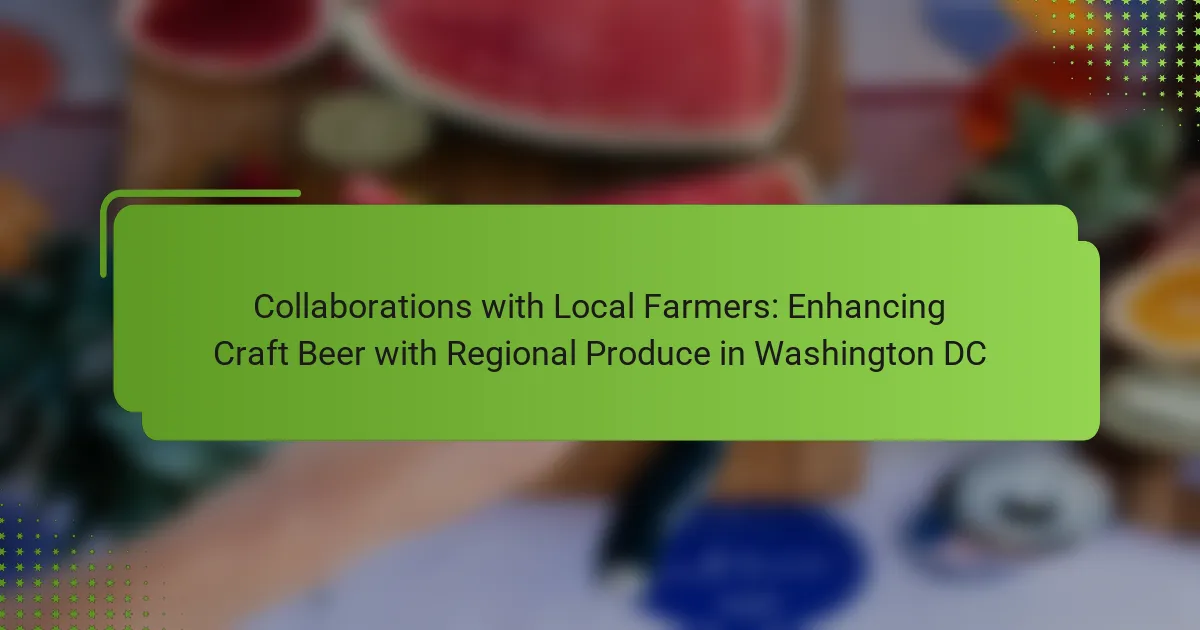Collaborations with local farmers in Washington DC play a crucial role in enhancing craft beer through the use of seasonal produce. These partnerships support sustainable practices, strengthen community ties, and promote local economies while providing craft breweries access to fresh ingredients. However, breweries face challenges such as crop yield variability, logistical issues, and regulatory hurdles that can complicate these collaborations. Successful examples, including partnerships between DC Brau and 3 Stars Brewing Company with local farms, highlight the benefits of these relationships in creating unique beer flavors and fostering awareness of local agriculture’s significance in the craft beer industry.

What are the key aspects of collaborations with local farmers in Washington DC?
Key aspects of collaborations with local farmers in Washington DC include sourcing fresh ingredients, supporting sustainable practices, and fostering community relationships. Collaborations allow craft breweries to access seasonal produce, enhancing flavor profiles in their beers. Local farmers benefit from direct sales and increased visibility. These partnerships often promote local economies and reduce carbon footprints. Events like farm-to-brewery tours strengthen connections between consumers and producers. Additionally, educational initiatives raise awareness about local agriculture’s role in the craft beer industry. Overall, these collaborations create a mutually beneficial ecosystem that supports both farmers and brewers.
How do these collaborations enhance craft beer production?
Collaborations with local farmers enhance craft beer production by integrating fresh, regional ingredients. This practice improves flavor profiles and promotes seasonal brewing. Craft breweries can create unique recipes that reflect local terroir. Utilizing locally sourced produce fosters community connections and supports local economies. Studies show that beers made with regional ingredients often receive higher ratings. Collaborations also encourage innovation, leading to new brewing techniques and styles. Furthermore, these partnerships can reduce transportation costs and carbon footprints. Overall, local collaborations contribute to the sustainability and distinctiveness of craft beer.
What types of regional produce are commonly used in craft beer?
Common types of regional produce used in craft beer include fruits, herbs, and grains. Fruits such as cherries, peaches, and blueberries are frequently added for flavor. Herbs like mint, basil, and lavender enhance aroma and complexity. Local grains, such as barley and wheat, form the base of many beers. Washington DC breweries often source these ingredients directly from nearby farms. This practice supports local agriculture and ensures freshness. The use of regional produce contributes to unique flavor profiles in craft beer.
How do local ingredients influence the flavor profile of craft beer?
Local ingredients significantly influence the flavor profile of craft beer. They introduce unique tastes and aromas that reflect the region’s agricultural diversity. For example, hops grown in specific climates can impart distinct bitterness and floral notes. Similarly, locally sourced grains can add unique malt characteristics, enhancing the beer’s overall complexity. Additionally, fruits and spices from local farms can create innovative flavor combinations. Studies show that craft breweries using regional ingredients often receive higher ratings for flavor authenticity. This connection to local agriculture fosters community support and promotes sustainable practices in brewing.
Why are local farmers important to the craft beer industry?
Local farmers are crucial to the craft beer industry because they provide fresh, high-quality ingredients. These ingredients, such as grains, hops, and fruits, enhance the flavor profiles of craft beers. Sourcing locally supports sustainable farming practices and reduces transportation emissions. Additionally, it fosters community relationships between brewers and farmers. This collaboration promotes local economies by keeping money within the community. Many craft breweries prioritize local sourcing to create unique, regionally inspired beers. Such practices can also attract consumers who value local products. Overall, the partnership between local farmers and craft breweries enriches the industry and the community.
What economic benefits do these collaborations provide to local farmers?
Collaborations with local farmers provide significant economic benefits to them. These partnerships increase farmers’ income through direct sales to breweries. Farmers gain access to new markets, enhancing their revenue streams. Collaborations often lead to higher demand for locally sourced ingredients. This demand can result in better pricing for farmers compared to wholesale markets. Additionally, these partnerships foster community support for local agriculture. According to the USDA, local food systems can boost farm profitability by up to 30%. Overall, collaborations can create a sustainable economic model for local farmers.
How do partnerships with local farmers support sustainable practices?
Partnerships with local farmers support sustainable practices by promoting environmentally friendly agricultural methods. These collaborations often prioritize organic farming techniques. Organic farming reduces chemical pesticide usage, which benefits local ecosystems. Additionally, local sourcing minimizes transportation emissions, decreasing the carbon footprint. Studies show that local farms tend to use crop rotation and cover cropping, enhancing soil health. This approach also fosters biodiversity, as diverse crops attract various beneficial insects. Furthermore, partnerships can lead to shared knowledge on sustainable techniques, improving overall farming practices. Research indicates that local farms can reduce food waste through direct supply to nearby breweries. Overall, these partnerships create a more sustainable food system that benefits both farmers and the community.

What challenges do breweries face in collaborating with local farmers?
Breweries face several challenges when collaborating with local farmers. One major challenge is the variability of crop yields. Weather conditions can affect the quantity and quality of produce available. Additionally, breweries may encounter logistical issues in sourcing ingredients. Transportation and storage can complicate the supply chain. Another challenge is aligning production schedules. Farmers have specific harvest times that may not coincide with brewery needs. Breweries might also face higher costs for locally sourced ingredients. This can impact pricing and profitability. Furthermore, there may be a lack of established relationships between breweries and farmers. Building trust and communication takes time and effort. Lastly, regulatory hurdles can complicate collaborations. Compliance with local laws regarding food and beverage production can be complex. These factors collectively hinder effective partnerships between breweries and local farmers.
How can breweries overcome sourcing difficulties?
Breweries can overcome sourcing difficulties by establishing partnerships with local farmers. These collaborations can ensure a steady supply of fresh ingredients. Local sourcing reduces transportation costs and time. It also supports regional economies and promotes sustainability. Breweries can tap into unique local flavors, enhancing their product offerings. This strategy has been proven effective; for instance, breweries in Washington DC have successfully integrated local produce into their recipes. Engaging with farmers can also lead to innovative brewing techniques and product development. By fostering these relationships, breweries can mitigate sourcing challenges and create distinctive craft beers.
What logistical issues arise when working with local produce?
Logistical issues when working with local produce include limited availability and seasonal fluctuations. Local produce often has a shorter shelf life compared to imported goods. This necessitates more frequent deliveries, increasing transportation costs. Additionally, coordinating with multiple local suppliers can complicate supply chain management. Quality control may vary between suppliers, affecting consistency in the final product. Local produce may also require specialized handling and storage conditions. Compliance with local regulations can introduce further challenges. Finally, market demand may fluctuate, leading to surplus or shortages.
How do seasonal variations affect ingredient availability?
Seasonal variations significantly impact ingredient availability for craft beer production. Different crops thrive during specific seasons, affecting the supply of local produce. For example, hops are typically harvested in late summer, while certain fruits are available in late spring or early summer. This timing influences when brewers can source fresh ingredients. Additionally, weather conditions can alter harvest yields, further affecting availability. Regions with distinct seasons may experience fluctuations in ingredient quality and quantity. Local farmers often align their planting schedules with these seasonal changes, ensuring a fresh supply for brewers. Such collaborations enhance the uniqueness of craft beer by incorporating seasonal ingredients.
What role does community engagement play in these collaborations?
Community engagement is crucial in collaborations with local farmers for enhancing craft beer. It fosters relationships between breweries and farmers. These relationships enable breweries to source fresh, regional produce. Engaged communities contribute to sustainable practices in agriculture. They also support local economies by promoting farm-to-table initiatives. This connection enhances the authenticity of craft beer offerings. Engagement leads to shared knowledge about local ingredients and brewing techniques. Ultimately, it creates a stronger sense of community identity and pride.
How can breweries foster relationships with local farmers?
Breweries can foster relationships with local farmers by sourcing ingredients directly from them. This practice supports local agriculture and strengthens community ties. Breweries can engage in collaborative events, such as farm tours and beer tastings. These events promote awareness of local produce and create personal connections. Additionally, establishing contracts for regular ingredient supply ensures farmers have a reliable market. Breweries can also participate in farmers’ markets to showcase their products. This visibility benefits both parties by increasing customer engagement. Research indicates that local sourcing can boost a brewery’s reputation and sales. A study by the Brewers Association shows that 70% of craft beer consumers prefer locally sourced ingredients.
What impact does community support have on successful collaborations?
Community support significantly enhances successful collaborations. It fosters trust and open communication between stakeholders. This support can lead to shared resources and knowledge. For instance, local farmers may provide fresh produce to craft breweries. In return, breweries can promote these farmers, creating a mutually beneficial relationship. Research indicates that community engagement boosts project sustainability. A study by the American Journal of Community Psychology highlights that community involvement increases collaboration effectiveness. Thus, community support is crucial for achieving successful partnerships in local initiatives.

What are some successful examples of collaborations in Washington DC?
Successful examples of collaborations in Washington DC include partnerships between local breweries and farmers. These collaborations enhance craft beer with regional produce. For instance, breweries like DC Brau have worked with local farms to source ingredients. They have utilized fresh fruits and herbs in their brewing process. Another example is 3 Stars Brewing Company, which collaborates with area farms for seasonal ingredients. These partnerships not only support local agriculture but also create unique beer flavors. Such efforts have been recognized at events like the DC Beer Festival. These collaborations exemplify the synergy between local agriculture and the craft beer industry in Washington DC.
How have specific breweries integrated local produce into their offerings?
Specific breweries have integrated local produce into their offerings by sourcing ingredients directly from nearby farms. For example, breweries like DC Brau and 3 Stars Brewing Co. have collaborated with local farmers to use seasonal fruits and vegetables in their beers. These collaborations enhance flavor profiles and create unique seasonal brews. Additionally, some breweries have hosted farm-to-table events, showcasing local produce in their beer recipes. This practice supports local agriculture and promotes community engagement. The use of local ingredients also resonates with consumers who prioritize sustainability and freshness in their craft beer choices.
What unique craft beers have emerged from these collaborations?
Unique craft beers that have emerged from collaborations with local farmers in Washington DC include “Farmhouse Ale” brewed with locally sourced grains and herbs. Another example is “Berry Wheat,” made using fresh berries from nearby farms. “Honey Lavender Saison” incorporates honey and lavender sourced from local producers. “Pumpkin Ale” features pumpkins grown by local farmers, enhancing seasonal flavors. Each of these beers highlights the use of regional produce, showcasing the connection between craft brewers and local agriculture. This approach not only supports the local economy but also creates distinctive flavors reflective of the region’s bounty.
How do customer responses reflect the success of these collaborations?
Customer responses indicate the success of collaborations through positive feedback and increased sales. When customers express satisfaction, it often leads to repeat purchases. Positive reviews on social media platforms highlight the quality and uniqueness of the craft beer. Increased foot traffic in breweries showcases heightened interest in collaborative products. Surveys often reveal a preference for locally sourced ingredients among consumers. Sales data typically shows a correlation between collaborative launches and revenue spikes. Additionally, customer engagement in events featuring local farmers demonstrates community support. These factors collectively affirm that customer responses are a reliable measure of collaboration success.
What best practices can breweries adopt for effective collaborations?
Breweries can adopt several best practices for effective collaborations. Establish clear communication channels between all parties involved. Regular meetings can help align goals and expectations. Define roles and responsibilities to ensure accountability. Create a shared vision that reflects the interests of both breweries and farmers. Utilize local resources to strengthen community ties. Develop a timeline for project milestones to track progress. Document agreements to avoid misunderstandings. Seek feedback throughout the collaboration to make necessary adjustments. These practices enhance the quality of craft beer and promote regional produce effectively.
How can breweries ensure quality and consistency in their local produce sourcing?
Breweries can ensure quality and consistency in their local produce sourcing by establishing strong relationships with local farmers. Regular communication with farmers helps breweries understand the growing practices and seasonal availability of produce. Implementing quality control measures during the sourcing process is essential. This includes inspecting produce for freshness and quality upon delivery. Breweries can also conduct regular taste tests to ensure that the flavor profiles meet their standards.
Additionally, developing contracts that specify quality expectations can help maintain consistency. Educating farmers about the brewery’s requirements can lead to better alignment in produce quality. Tracking and documenting the sourcing process allows breweries to identify any issues and address them promptly. According to a study by the Brewers Association, breweries that prioritize local sourcing often report higher customer satisfaction and product quality.
What strategies can enhance collaboration between breweries and farmers?
Strategic partnerships can enhance collaboration between breweries and farmers. Establishing direct supply chains is essential. This allows breweries to source fresh ingredients from local farms. Implementing joint marketing campaigns can promote both entities. Collaborative events, such as farm-to-brewery tours, can attract customers. Sharing knowledge on sustainable practices benefits both parties. Regular meetings to discuss needs and challenges foster communication. Utilizing social media to highlight partnerships can increase visibility. These strategies have been shown to strengthen local economies and build community ties.
Collaborations with local farmers play a vital role in enhancing craft beer production in Washington DC by integrating fresh, regional produce. These partnerships not only improve flavor profiles and promote sustainability but also support local economies and foster community relationships. Key aspects include sourcing seasonal ingredients, addressing logistical challenges, and the economic benefits for farmers. The article explores how local ingredients influence beer characteristics, successful examples of collaborations, and best practices for breweries to ensure quality and consistency in sourcing. Overall, these collaborations create a mutually beneficial ecosystem for both farmers and craft brewers.
